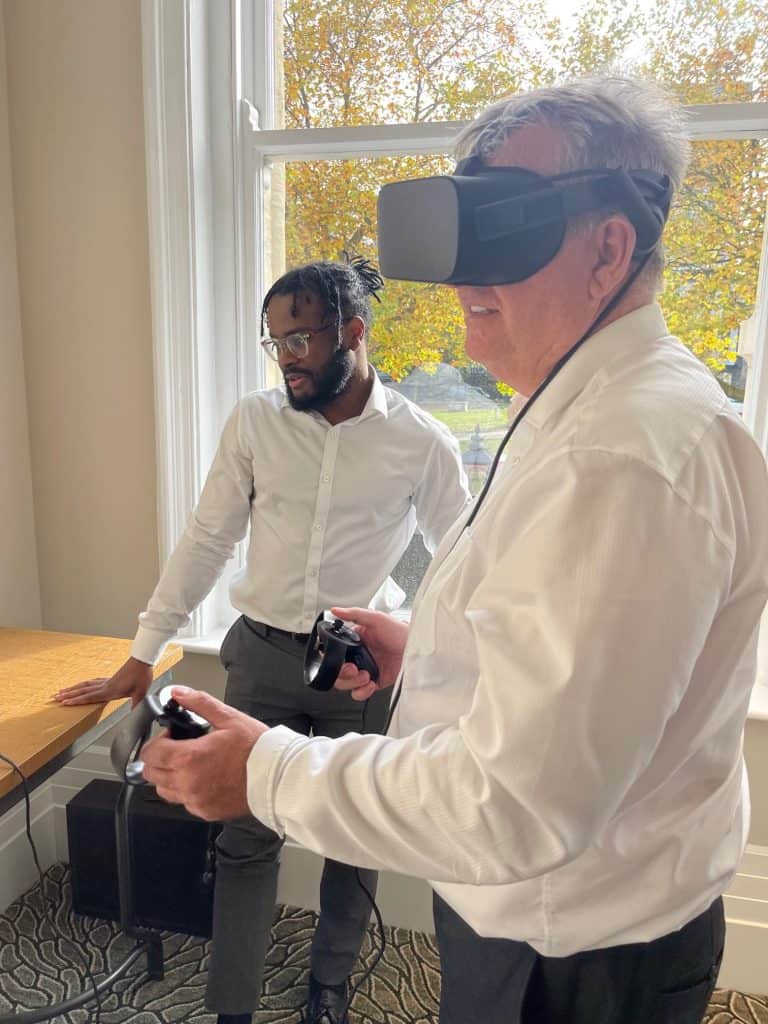Last November, we hosted two roundtable events in London and Birmingham to explore how the Public Sector can ‘Maximise Value Through Digital Construction’ in fit-out and refurbishment projects.
The well-attended events allowed for topical conversations from representatives across local government, central government, and professional services, including architectural design, services designers, and project managers.
The CPD accredited events were led by our framework team, Josh Armstrong in London and Jolene McLaren in Birmingham, along with our Digital Construction team, Amador Caballero and Lemar Whyte. The events were also attended by our framework partner Procurement Hub.

Image above: The attendees at the digital construction roundtable breakfast.
The sessions explored:
- Live examples on how to achieve and maximise value using Digital Construction in a fit-out and refurbishment project
- The public sector’s challenges in implementing the Construction Playbook (which guides public bodies on BIM implementation) and how to comply and address misconceptions in the industry.
It was a great opportunity for estates professionals and consultants to open discussion on the topics raised.

Image above: Lemar Whyte demonstrating some of the tools to Andrew Peck from Procurement Hub
Some of the key takeaways of the discussions were:
- There are still many misconceptions around BIM and a lack of understanding of the benefits that it can bring at the different stages of the project.
- Some customers request not to implement BIM on their projects because they think it will imply an additional cost. However, there are examples of projects where the BIM principles were implemented during the design development despite the customer’s decision and awareness.
- Although the most significant benefit of BIM is during the operations and maintenance, it also brings benefits during the design and construction phases, providing an overall saving to the customer if implemented at an early stage.
- Corporate estates in the public sector vary greatly. Therefore, the adoption of BIM is not consistent, as it may be implemented on one project but not considered on another, limiting the benefits to the FM team.
- The councillors who sign off projects may have bureaucratic motivators for agreeing or pulling projects; they may not be interested in the long-term benefits of a BIM-led design when looking at the short-term elections.
- The private market has a more prominent apathy than the public sector implementing BIM. As mentioned early, this is due to the misconception that BIM has a cost impact and doesn’t appreciate the benefits it can bring at different project stages.
- The importance of the survey cannot be seen as a cost and needs to be considered a method to save money during the construction stage.
- Our industry is concerned about the short-term cost instead of appreciating the benefits in the long term and the savings that the survey can bring during the construction stage, and how BIM can support the design, construction, and operations of the building.
- BIM implementation must be considered at the feasibility stage and specify the correct documentation to reflect the project requirements.
- Customers to ensure the BIM models and documentation are provided at the tender stage to allow contractors to assess the information and price accordingly. Currently, models are not shared until contract award, not allowing this information for quantities take off, logistics, phasing and assess the design coordination.

Image above: Lemar Whyte, Andrew Peck from Procurement Hub and Amador Caballero
Andrew Peck, Client Relationships Manager at Procurement hub said;
“A really enjoyable session by Amador Caballero Ruiz (Head of Digital Construction) at Willmott Dixon Interiors. The session included how to achieve and maximise value through the use of digital construction in your fit out and refurbishment projects.
As the construction sector provides guidance to public bodies on how to implement BIM, we explored the challenges the public sector faces in implementing the guidance, how to comply and address misconceptions in the industry. As Procurement Hub has over 600 members in the public sector, this was an invaluable morning.”
Further key takeaways of the discussions were:
- On some occasions, the information provided is not project-specific and too vague, and contractors may increase their fees to cover their risk.
- BIM documents can become too complex, making implementing, and engaging different supply chain parents more difficult. Hence, it the importance to clarify the BIM principles with all companies at the earliest opportunity.
- Funders must be motivated to implement BIM, hence the importance of sharing the benefits of BIM and providing evidence of working with skilled designers and contractors.
- Professionals should collaboratively guide and highlight the benefits of adopting BIM early in the design phase when discussing options with stakeholders and decision-makers.
- The process must be defined and implemented with the entire team on board as early as possible. We require all designers and contractors with the right skills and be part of the process to ensure successful delivery. In addition, working with the correct supply chain is critical.
- It was clear that collaboration between the customer, designers, contractor, and leading on to specialist supply chain partners is vital, especially when delivering refurbishments to historic buildings or those lacking information.
- It is essential that all team members follow the ISO and British Standards and avoid bespoke documentation to support the information management more efficiently.
- The consensus from the Mechanical & Electrical designer that benefits are evident when an M&E contractor is identified through the main contractor to sit alongside the designers through Stage 4.
- The use of models and technology can increase prefabrication and support the carbon agenda.
- Technology has changed over the years, making the models and data more accessible to customers and people on-site without having high spec hardware or extensive software knowledge.
- The Pandemic has helped encourage digital collaboration, online meetings, accessing drawings online, and reducing printing.
- A clear consensus was that BIM implementation would help the industry’s performance.
- The end-user should be engaged during the different stages of the project to ensure the BIM deliverables comply with their expectations.
Thank you to all those who attended this event and we look forward to hosting more in 2022.
